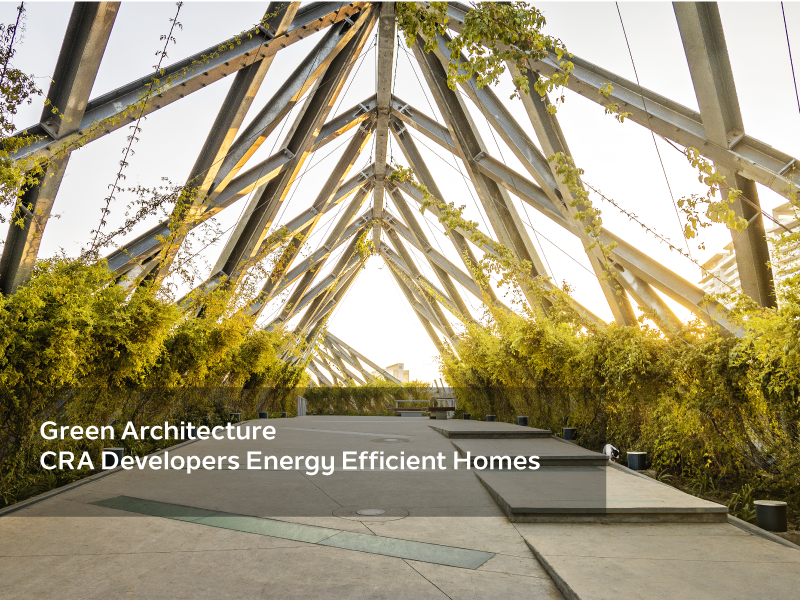The Future of Homes is Green — Literally
Let’s be honest. The way we used to build homes 20 or even 10 years ago doesn’t really fit the world we live in today. Rising electricity bills, climate changes, and the constant noise about sustainability have made people rethink how they want to live. And rightfully so.
When you walk into a modern apartment built with green architecture in mind, you can actually feel the difference — cooler air, natural light streaming in, and a sense that the home breathes with you. It’s not magic. It’s smart design meeting sustainable technology.
That’s exactly what CRA Developers has mastered with their energy-efficient housing projects. They’re not just constructing walls and roofs; they’re creating living spaces that respect nature while taking care of the people inside.
So, what exactly is green architecture, and why are so many people talking about it? Let’s take a deep dive into how this new way of building homes is quietly transforming urban living — especially in cities like Delhi, Gurugram, and Noida, where every square foot (and every watt of energy) counts.
What Is Green Architecture, Really?
Before we go into the details, let’s clear up one thing: green architecture isn’t just about planting a few trees around the building or painting the walls green (though that does look nice). It’s a full philosophy — a way of designing homes that work with nature instead of against it.
The core idea is simple: build homes that save energy, use fewer resources, and create healthier environments for people to live in. From the orientation of windows to the materials used in the walls, every single choice is made with sustainability in mind.
CRA Developers have adopted this approach in their housing designs, ensuring that every project contributes to a more energy-efficient lifestyle.
Bonus: Sustainable Homes in India: The 2025 Buyer’s Guide
The Foundation of Green Architecture
1. Energy Efficiency from the Ground Up
It starts with the basics — how the building faces the sun. CRA Developers’ design team carefully studies the natural light pattern before even laying the first brick. By positioning the structure to maximize natural daylight, they reduce the need for artificial lighting during the day.
Walls and windows are insulated, preventing unnecessary heat gain in summer and keeping the interiors warm in winter. This cuts down air conditioning costs significantly. It’s a subtle change, but one that your electricity bill will thank you for.
2. Sustainable Materials
Traditional materials often harm the environment during production — think cement, steel, or bricks. In contrast, green architecture uses eco-friendly alternatives like fly-ash bricks, low-VOC paints, and recycled steel. CRA Developers make sure their materials are both durable and kind to the planet.
These materials also make homes healthier. You breathe cleaner air, avoid exposure to harmful chemicals, and the structure lasts longer without constant maintenance.
3. Smart Water Management
In cities, water shortage is a daily reality. CRA Developers integrate rainwater harvesting systems and water recycling units into their green housing projects. Imagine reusing treated greywater for gardening or flushing — it’s a small step that saves thousands of litres annually.
Their approach makes every drop count, and when you see the system working effortlessly, you realise that sustainability doesn’t have to be complicated.
Comfort Meets Conscious Living
Here’s the beautiful part about green architecture — it’s not just good for the planet, it’s good for you too.
Think about it: less energy consumption means lower bills. Better ventilation means fewer respiratory problems. More greenery around means reduced heat in your surroundings. It’s not just about saving the earth — it’s about improving your quality of life.
Many residents in CRA Developers’ eco-conscious communities have reported a visible difference in their day-to-day comfort. They feel more relaxed, sleep better, and even say their homes feel “alive.” That’s what happens when your living space aligns with nature instead of fighting it.
Bonus: Top Real Estate Trends & Forecasts for 2025 That Will Shape the Indian Market
Why CRA Developers Are Leading the Green Revolution
1. Long-Term Vision Over Short-Term Profit
Let’s face it — not every builder wants to invest in sustainable technologies. They can be expensive initially. But CRA Developers look beyond immediate returns. Their philosophy revolves around long-term value — for both the homeowner and the planet.
When they design a housing project, they think about how it will age gracefully. Efficient layouts, smart lighting, waste management systems — every detail is chosen to ensure the building remains energy-efficient even decades later.
2. Blending Technology with Tradition
One thing that sets CRA Developers apart is how they balance modern engineering with practical Indian living. For example, large balconies for natural air circulation, high ceilings that prevent heat accumulation, and locally sourced materials that suit the regional climate.
It’s a fusion of traditional wisdom and modern technology — and that’s exactly what green architecture is all about.
3. Transparency and Trust
Green housing isn’t just a marketing buzzword for CRA Developers. They actually walk the talk. Their projects are designed following green building standards, and they’re open about the techniques they use.
This transparency builds trust with homeowners — especially those who are conscious about where their money and energy are going.
A Look at How Energy Efficiency Impacts Daily Living
1. Lower Energy Bills
This one’s obvious but powerful. When your home stays cooler in summer and warmer in winter naturally, you use less power for ACs and heaters. Over the years, the savings add up significantly — sometimes even covering the extra cost of a green-certified home.
2. Healthier Indoor Air
Ever walked into a home that feels stuffy or smells like paint even months after renovation? That’s what poor material choice does. CRA Developers use paints and adhesives with low volatile organic compounds (VOCs), which means cleaner air indoors.
Better ventilation and natural light also help in reducing mold and dampness, making your home healthier for everyone, especially kids and elderly family members.
3. Quieter, More Peaceful Spaces
Good insulation doesn’t just save energy — it blocks outside noise too. Living in an energy-efficient home by CRA Developers often means enjoying more peace and quiet, even if your apartment is near a busy street.
4. Increased Property Value
There’s another overlooked benefit. Homes built with green architecture tend to appreciate faster. Buyers today want sustainable living spaces, and projects by CRA Developers often stand out in the real estate market because of their eco-friendly reputation.
Bonus: Real Estate Developers: Shaping Modern Living and Investment Opportunities
Real-Life Example: How CRA Developers Implement Green Architecture
Let’s take one of CRA Developers’ recent projects as an example (without naming specifics). The building design incorporated:
Solar panels on rooftops to generate clean electricity.
A rainwater harvesting system that reduces water waste.
LED lighting across all common areas.
Natural ventilation corridors to reduce dependence on mechanical cooling.
A waste segregation system that supports recycling.
When you combine all these small yet impactful choices, the result is a residential complex that consumes 30–40% less energy than conventional buildings of the same size. That’s a huge win — both economically and environmentally.
The Emotional Connection to Living Green
There’s also something deeply emotional about living in a space that aligns with your values. When you know your home isn’t harming the planet, there’s a sense of pride that comes with it.
You start to notice small changes in your habits — switching off unnecessary lights, separating waste properly, reusing water — not because someone told you to, but because the environment around you encourages it.
CRA Developers often say that once people experience green living, they rarely go back to the old way of living. It becomes part of their lifestyle.
The Challenges — And Why They’re Worth It
Sure, green architecture isn’t always the easiest path. Eco-friendly materials sometimes cost more. Designs take longer to finalize. And explaining the benefits to first-time homebuyers can be a task.
But here’s the thing — the long-term gains far outweigh the short-term challenges. Lower maintenance costs, improved durability, and a healthier environment are benefits that last for decades.
CRA Developers believe in this balance. They know that when you invest in the right things today, you build a better tomorrow — not just for yourself, but for generations to come.
Tips for Homebuyers Looking for Green Architecture Homes
If you’re in the market for a new home and want to choose wisely, here are a few quick things to check before you buy:
✅ Look for natural ventilation and daylight in the floor plan.
✅ Ask about the insulation material used in walls and windows.
✅ Check if the project has rainwater harvesting or solar installations.
✅ Choose builders like CRA Developers with a track record of sustainable projects.
✅ Consider long-term savings, not just upfront costs.
A little research goes a long way in ensuring you buy a home that’s good for your pocket and the planet.
Bonus: Delhi Master Plan 2041: A Game-Changer for Urban Growth Near Rohini
Conclusion: Building a Greener Tomorrow with CRA Developers
At the end of the day, green architecture isn’t just a trend — it’s the future of responsible living. It’s about creating homes that give more than they take, homes that are comfortable, efficient, and built with purpose.
CRA Developers have shown that sustainability and luxury don’t have to be opposites. Their housing projects stand as proof that modern urban living can still be harmonious with nature.
So, if you’re looking for a home that’s energy-efficient, thoughtfully designed, and built by a developer who genuinely cares, CRA Developers’ green architecture projects are worth exploring.
Because when your home lives in harmony with the planet, you don’t just save energy — you create energy for a better life.

